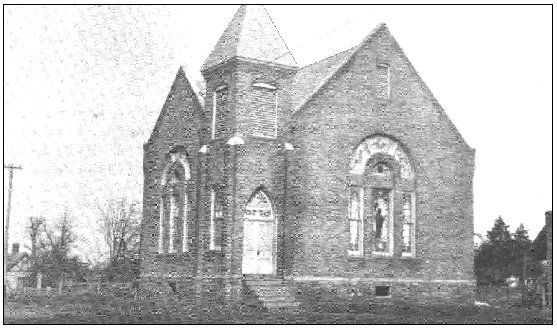

| W |
The church membership today is celebrating 150 years of existence in White County with a church service and potluck luncheon.
The church was organized July 16, 1850, by Alexander Stevenson and J.A. Wilson, who were ministers from Tennessee, according to Howard Johnson, a Search church elder and clerk of session. However, members were an active influence in White County for several years prior to the actual organization.
"Friday 4, 1810, in Dixon County, Tennessee – the men prayed all night before they decided to break away," Johnson offered. Members first began meeting in the homes of members. The Burrow, Steele and Meek families were among the charter members. The Cumberland Presbyterians formed the Arkansas Presbytery in 1824 and began to dispatch preachers throughout the area, Johnson offered.
A publication entitled "Searcy, Arkansas – A Frontier Town Grows Up With America" written by Raymond Lee Muncy says R.D. King claimed that at his meetings there were grown men who had never heard a public prayer, much less a sermon. The Methodists formed the Little Red River Mission in 1842 with Bishop A.L. Kavanaugh in charge. Searcy was then made a post on a circuit rider’s rounds. In 1851, Israel Moore deeded the church a lot and a small log cabin was built on the southeast corner where Main and Race streets intersect and served as Searcy’s first church building. James Kellum, Stephen Perry and Robert Carlisle were among the charter members. The name of the mission was changed to Searcy Mission and R.G. Brittian became Searcy’s first resident Methodist preacher.
The Baptists began meeting in 1847 but were not organized until June 1851 under the name of Shiloh Baptist Church of Christ by Elder John Goad. In 1853, Henry Becket gave property at Arch and Gum streets, across from the Wilbur D. Mills Court Building, to the church for the purpose of locating a meeting place. The church was never built at this location.
On May 28, 1859, Johnson said, the Cumberland Presbytery and the Southern Presbyterian agreed to jointly purchase a lot, building a church at the current location, the corner of Spring and Race streets. It was a wooden structure, according to Johnson. This arrangement continued until the Cumberland Presbyterian Church purchased the Southern Presbyterian's interest. The Southern Presbyterian purchased a lot at the corner of East Center and Main in 1891, Johnson offered. A sidewalk leading to the blank wall remains today.
In 1903, while F.Z. Nesbitt filled the pulpit, the current facility, located at 100 East Race, was constructed. Above the front door of the structure are the words "Cumberland Presbyterian Church 1903" etched in stained glass. Stained glass windows depicting Bible scripture and imaging "Christ knocking at the door," and "an angel sitting on a tomb," also adorn the sanctuary.
"Records are lost from the early years around the time this was built," Johnson said. "We don’t know much about the building project. It would be interesting to know where the windows came from and how much they cost." The sanctuary is also listed on the state Historical Society’s register.
"When Judsonia was blown away by the tornado some of the stained glass windows were damaged in this church," Johnson said. Replacement glass was installed and it is almost impossible to detect the difference. Also, the original pulpit featuring a carved dove sits inside the sanctuary. Today it serves as a holder for the registration book.
Johnson has been attending the church for about 25 years. His wife Sandra (Joyner) has been attending the church since she was a small child. "Our wedding was here," he said. Sandra also serves as organist for the church. "Most of the members are people who have grown up here," she said.
Other churches have also used the facility, such as the First Christian Church of Searcy which was organized November 1, 1906. The Cumberland Presbyterian Church invited the members to use their facilities.
Churches were growing in membership in Searcy during the Roaring Twenties. In 1928, the First United Methodist Church was the largest with about 500 members, followed by the Gentry Baptist, with 250 members; the West End Methodist Church, with 160 members; the Cumberland Presbyterian with 100 members; the Missionary Baptist with 95 members, and the First Christian Church, with 75 members, the Nazarene Church with 74, First Presbyterian 57 and Seventh Day Adventists, 50 or more.
During the past 150 years, Johnson said, 7,800 morning worships have been delivered. Today, the membership is small, Johnson said. However, he said, "This church has been an influence in this community all these years."
Former church ministers noted
Ministers at the Cumberland Presbyterian Church include:
1850-52, Reverend Alexander Stevenson; although the dates are not available the second minister was Robert Scott Bell; 1855-56, D.P. Coffey; 1856-58, R.S. Bell; Civil War records are lost; 1869-72, Alexander Stevenson; 1871-72, Reverend James Smith; 1872-74, R.B. Cavett; 1874-91, no record; 1891-94, J.T. Buchanan; 1894-95, F.M. Wylie; 1895-95, G.H. Weaver; 1900-04, F.Z. Nesbitt; 1904-07, J.S. Hall; 1908-12, J.M. Russell; 1912-14, W.W. Rudolph; 1915-16, J.L. Price; 19178-20, J.S. Hall; 1920-22, G.F. Carter; 1923-30, Russell Tatum; 1937, W.R. Reid and Reverend Mrs. Maybell Reed; 1937-39,W.C. McConnell; 1940-42, Smith Cunningham; 1943-47, Russell Tatem; 1947-53, H.L. Hinch; 1954-55, E.W. Johnson; 1955-58, R.R. Deland; 1958-62, Tom Sisk; 1962-63, Raymond Kinslow; 1963-68, Park McCullah; 1969-73, Terril D. Maynard; 1973-77, Albert J. Smith; 1977-80, James Lampley; 1980-81, Joe Mattock and David Brown; 1981-82, Stan Rush; 1983, Dr. Hubert Marrow; 1983-86, Walter E. Russell with associate, Reverend Esther Smith, 1898-93; 1988-91, James Lively; 1991-94, Rickey Page; 1994-95, Keith Marriott; 1995-97, Dr. Thomas D. Campbell; 1997, Jim Bradberry; Interim until now, seminary students.